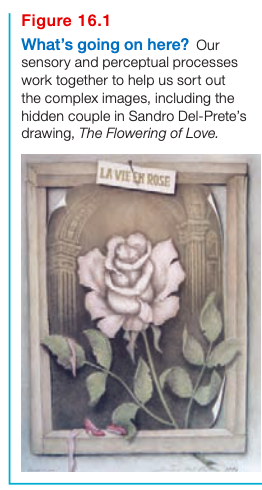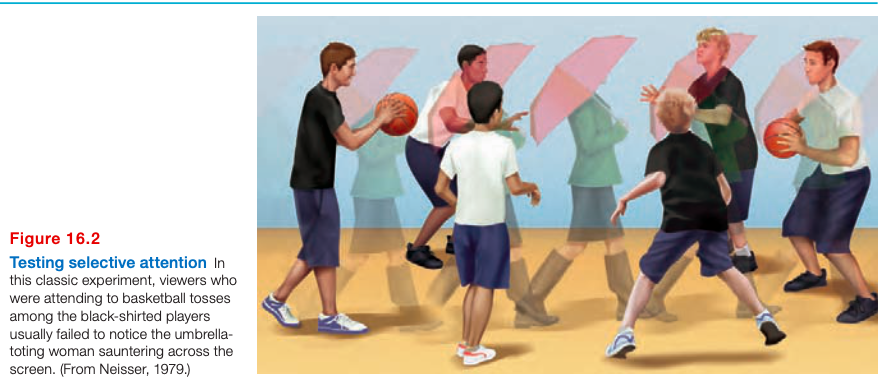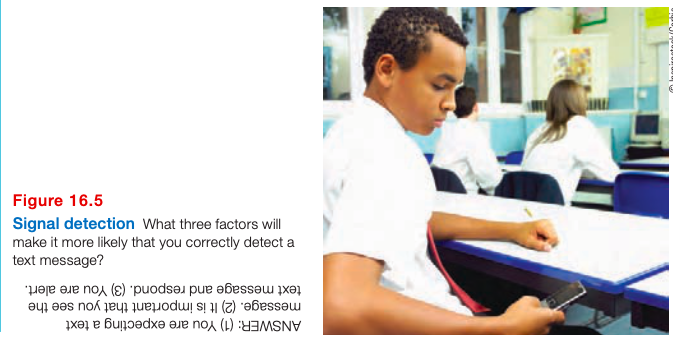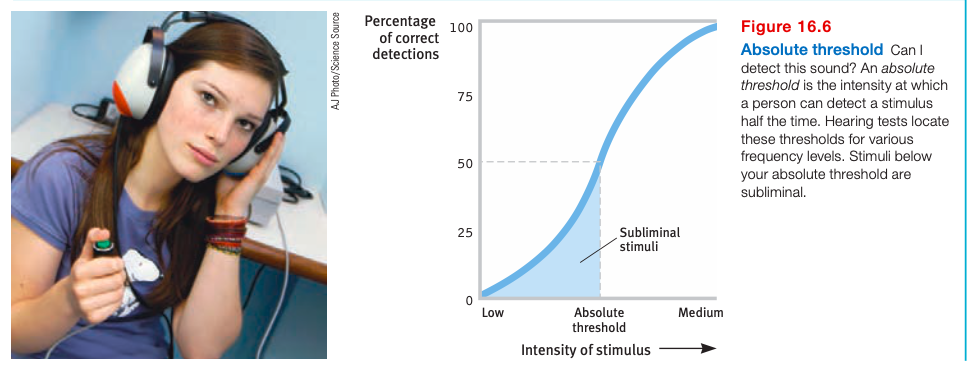Module 16: Basic Principles of Sensation and Perception
16-1: What are sensation and perception? What do we mean by bottom-up processing and top-down processing?
- ^^Sensation:^^ process by which our sensory receptors and nervous system receive and represent stimulus energies from our environment
- ^^Perception^^: process of organizing and interpreting sensory information, enabling us to recognize meaningful object and events
- Like remembering hair, gait, voice, or physique
- Sensation and Perception are parts of one continuous process
- ^^Bottom-up Processing:^^ analysis that begins with the sensory receptors and works up to the brain’s integration of sensory information
- Enables our sensory systems to detect the lines, angles, and colors that form the flowers and leaves (Figure 16.1)
- Breaking things down to form something
- ^^Top-down processing^^: information processing beginning with our higher-level mental processes, as when we construct perceptions drawing on our experience and expectations
- Interpret what our senses detect
Selective Attention
16-2: How much information do we consciously attend to at once?
^^Selective attention:^^ focusing of conscious awareness on a particular stimulus
Cocktail party effect: ability to attend to only on voice among many (while also being able to detect your own name in an unattended voice)
We selectively attend to, and process, a very limited portion of incoming information, blocking out much and often shifting the spotlight of our attention from one thing to another

Selective Inattention
^^Inattentional blindness^^ (Figure 16.2): failing to see visible objects when our attention is directed elsewhere

- A by-product of what we are really good at: focusing attention on some part of our environment
^^Change blindness^^ (Figure 16.3): failing to notice changes in the environment

Transduction
16-3: What three steps are basic to all our sensory systems?
- Everyday our sensory systems convert one form of energy into another
- ex: vision processes light energy, hearing processes sound waves
- All our senses:
- Receive sensory stimulation, often using specialized receptor cells
- Transform that stimulation into neural impulses
- Deliver the neural information to our brain
- ^^Transduction^^: process of converting one form of energy into another our brain can interpret
- ex: stimulus energies like sights, sounds, and smells into neural impulses
- ^^Psychophysics:^^ study of relationships between the physical characteristics of stimuli, such as their intensity, and our psychological experience
Thresholds
16-4: What are the absolute and difference thresholds, and do stimuli below the absolute threshold have any influence on us?
Absolute Thresholds
^^Absolute Threshold:^^ minimum stimulation necessary to detect a particular light, sound, pressure, taste, or odor 50% of the time
Detecting a weak stimulus, or signal, depends not only on the signal’s strength but also on our psychological state–our experiences, expectations, motivation, and alertness
^^Signal Detection Theory^^ (Figure 16.5): theory predicting how and when we detect the presence of a faint stimuli amid background stimulation, assumes that there is no single absolute threshold and that detection depends partly on a person’s experience, expectations, motivation, and alertness

^^Subliminal^^ (Figure 16.6): below one’s absolute threshold for conscious awareness (Stimuli you cannot detect 50% of the time)
Under certain conditions, you can be affected by stimuli so weak you don’t notice them

^^Priming^^: activation, often unconsciously, of certain associations, thus predisposing one’s perception, memory, or response
ex: an unnoticed image that reaches your visual cortex and briefly primes your response to a later
^^Backmasking^^: purposefully recording a message on a tape backward
^^Reverse speech:^^ looking for messages while playing a recording backwards
Much of our information processing occurs automatically, out of sight, off the radar screen of our conscious mind
Difference Thresholds
- To function effectively, we need our absolute thresholds low enough to allow us to detect important sights, sounds, textures, tastes, and smells
- We also need to detect small differences among stimuli
- ^^Difference Threshold:^^ minimum difference between two stimuli required for detection 50% of the time. We experience the difference threshold as a just noticeable difference
- Increases with the size of the stimulus
- ex: If you add 1 ounce to a 10-ounce weight, you will detect the difference; add 1 ounce to a 100-ounce weight and you probably will not
- ^^Weber’s law^^: principle that, to be perceived as different, two stimuli must differ by a constant minimum percentage, rather than a constant amount
- Exact proportion varies, depending on the stimulus
Sensory Adaptation
16-5: What is the function of sensory adaptation?
- ^^Sensory adaptation:^^ diminished sensitivity as a consequence of constant stimulation
- ex: entering your brother’s room, smelling a musty odor, wondering how they can stand it, but within minutes you no longer notice
- When we are constantly exposed to a stimulus that does not change, we become less aware of it because our nerve cells fire less frequently